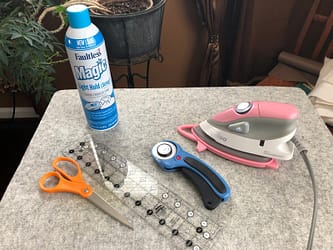Some quilters start their projects by washing all of the starch and sizing out of the fabric. Others start their projects by starching their pieces. Should I starch or size? When do I use which and why? HELP!
Starch and sizing can be a quilters friend, or a quilters enemy depending upon when and where you use it. The first thing to understand is what is the difference between sizing and starch. Alan Spielvogel from the American Cleaners Association provides a wonderful explanation that is summarized here. Starch is a mixture of water and plant-based starch, like corn starch. It gives fabric stiffness – think starched collars. Sizing has a resinous material (plant- or plastic-based) that doesn’t make fabric stiff. Instead, sizing gives fabric body, which is why it is routinely added to fabric at the manufacturer.
If sizing gives fabric body, why do quilters wash it out? There are a few reasons. Sizing can interfere with fusible interfacing and other materials such as spray basting. Washing fabrics first helps the adhesives and fusible work better as they stick to the fibers instead of the sizing. Sizing can cause allergic reactions for some people in the form of dermatitis or sneezing. Washing fabrics not only removes sizing but excess dyes that can bleed later. That covers a little on why not to size.
Why add sizing? Since sizing gives body without stiffness, some quilters will add it to their fabrics to remove wrinkles. The material remains supple, but will keep creases better in seams. Sizing may help when you nest seams, so you want seams clean, but not crisp.
If sizing works well for seams, why use starch? Starch has two wonderful uses in quilting. First, start prevents fibers from moving easy – thus stiffness. This is a wonderful quality when you are working with bias cut pieces. You don’t want the fabric to stretch out of shape. Starch prevents that stretching, so it is awesome for bias cut piecing. Also, starch makes fabric folds crisp, which is fantastic for finished edge applique. With finished edge applique, the seams allowance is pressed under the patch with the aid of freezer paper or other templates. Painting the seam allowance with starch and pressing it with a hot iron ensures the fabric will hold the shape you want.
Now that we know which is which and when to use them, did you know there is a proper way to use starch and sizing? It is not a simple spray and go process. You need to have patience grasshopper and let the starch or sizing soak into the fabric before pressing. This will minimize flaking and maximize hold.
Quilter instructors are great about teaching you how to cut and sew, but many don’t talk about fabric preparation and treatment. There are some notable exceptions, like Sue Pelland, who explained to our class why it was essential to wash fabric before fusing. Hopefully, this will fill in a few gaps in your fabric knowledge.
Happy Quilting!
Laureen

